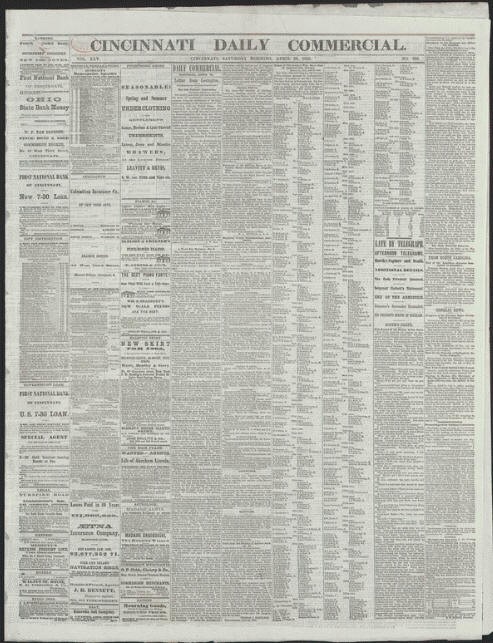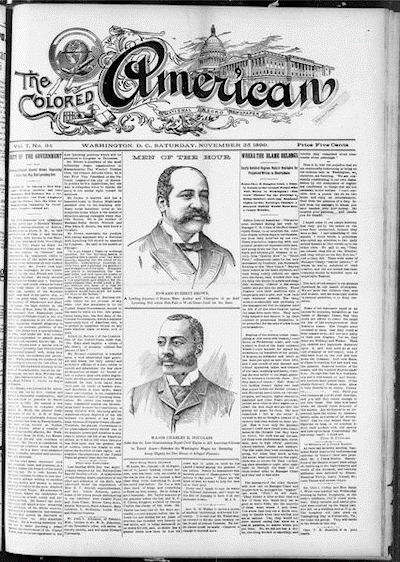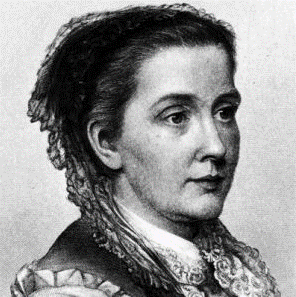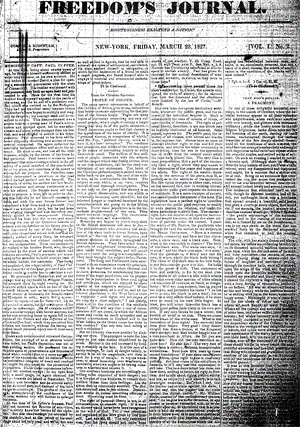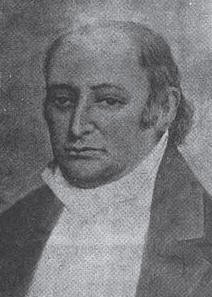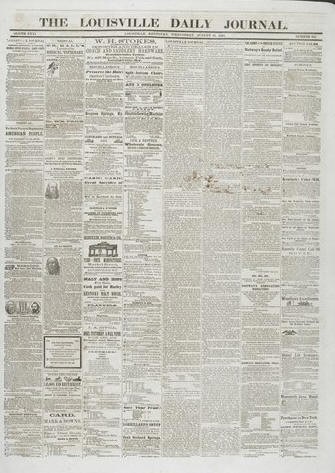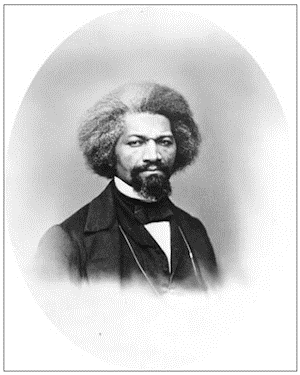Newspapers
Abolitionist (African American) Newspapers and their role regarding fugitive slaves and the anti-slavery movement.
There are 57 listed in alphabetical order under two headings: United States and Canada. Draft list – more details to follow.
United States |
Title: |
The African Methodist Episcopal Church Magazine |
| Location: | Albany, New York |
| Editor: | |
| Publisher: | |
| Publication Dates: | 1841 |
| Notes: | Sources: Hudson J. Blaine, ‘Encyclopedia of The Underground Railroad’. Published by McFarland & Company Inc, 2006. |
Title: |
African Observer |
| Location: | Philadelphia, Pennsylvania |
| Editor: | |
| Publisher: | |
| Publication Dates: | 1827 to 1828 |
| Notes: | The African Observer, subtitled “Illustrative of the General Character, and Moral and Political Effects of Negro Slavery”, was an abolitionist publication, published in Philadelphia, Pennsylvania as a monthly journal between 1827 and 1828. The African Observer published essays, source materials, and articles intended to diplomatically and objectively show white contemporaries the evils of the institution of slavery. Essays and documents also traced the early origin of the African slave trade from the continent of Africa to the coastline of America. |
Title: |
Aliened American |
| Location: | Cleveland, Ohio |
| Editor: | William Howard Day |
| Publisher: | William Howard Day |
| Publication Dates: | 1853 to 1855 |
| Notes: | The Aliened American not only was Cleveland’s first black newspaper, but apparently was also intended to be a regional voice. It was founded at the urging of the Ohio and Natl. Conventions of Colored Freemen from 1849-53. Three editors finally produced the paper’s inaugural issue on 9 Apr. 1853, at a time when they claimed there were only 2 other black papers in publication in the entire country. William Howard Day, a graduate of Oberlin College, was the paper’s actual editor-in-residence. He obtained the aid of corresponding editors Rev. Jas. W. C. Pennington of New York and Samuel Ringgold Ward, a former slave then living in Toronto. After the appearance of the initial issue, the Aliened American seems to have suspended publication for several weeks in order to assemble its subscription list. Thereafter, it published weekly until 1855, when Day moved to a black settlement in Buxton, Ontario. Renamed the People’s Exposition, it continued as a monthly for another year.
Sources: |
Title: |
Alton Observer |
| Location: | Alton, Illinois |
| Editor: | Elijah Lovejoy |
| Publisher: | |
| Publication Dates: | 1837 |
| Notes: | The Alton Observer was an abolitionist newspaper established in Alton, Illinois by the journalist and newspaper editor Elijah Lovejoy after he was forced to flee St. Louis, Missouri. Lovejoy left St. Louis, where he edited the St. Louis Observer, after his printing press was destroyed for the third time.
Although Illinois was a free state and Alton was an important Underground Railroad location, the city also had a large pro-slavery faction, including slave catchers and others dependent on slaves. The former earned money by their capture of slaves’ escaping across the Mississippi from Missouri. Southern Illinois had numerous slavery supporters, where farmers used slave labor for cultivation. On November 7, 1837 abolition opponents mobbed Gilman & Godfey’s warehouse where Lovejoy had hidden his printing press, and gunfire was exchanged between them and his supporters. Lovejoy and his supporters killed some in the mob and wounded others. While they were trying to prevent the burning of the warehouse, Lovejoy and Royal Weller were shot; Lovejoy died immediately. The mob threw the press out the window and into the river. Publication of the Alton Observer ended after Lovejoy’s murder, but his brother Owen Lovejoy became a leader of the abolitionists in Illinois and carried on the struggle. Elijah Lovejoy was considered a martyr (“a martyr on the Altar of American Liberty”) by abolitionists across the country. 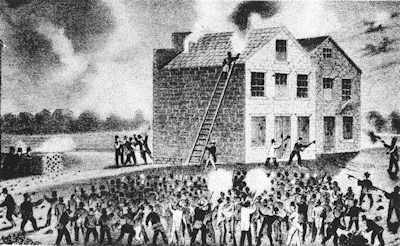 Wood engraving of the November 1837 pro-slavery riot in which Sources: |
Title: |
The Anglo-American |
| Location: | Cleveland, Ohio |
| Editor: | |
| Publisher: | |
| Publication Dates: | 1859 |
| Notes: | Sources: Hudson J. Blaine, ‘Encyclopedia of The Underground Railroad’. Published by McFarland & Company Inc, 2006. |
Title: |
The Anti-Slavery Bugle |
| Location: | New Lisbon (later re-named Lisbon), Ohio, then (after 5 issues) Salem, Ohio |
| Editor: | Editors were Marius R. Robinson, Benjamin S. Jones, J. Elizabeth Hitchcock and Oliver Johnson. |
| Publisher: | Ohio American Antislavery Society |
| Publication Dates: | 1845 to 1861 |
| Notes: | The Anti-Slavery Bugle was an abolitionist newspaper published from June 20, 1845, to May 4, 1861. It was first published in New Lisbon (later renamed Lisbon), Ohio, and moved shortly after five issues to Salem, Ohio. Salem was home to many Quaker families and an active station of the Underground Railroad, providing the paper with more subscribers. James Barnaby was the publisher of the paper and received support from the Anti-Slavery Society, such as Abby Kelley. This allowed the paper to continue to be in circulation for 18 years and was shipped to other states, including Illinois, Iowa, Indiana and Wisconsin. The paper stated its goal in the first issue: “Our mission is a great and glorious one. It is to preach deliverance to the captive, and the opening of the prison door to them that are bound; to hasten in the day when ‘liberty shall be proclaimed throughout all the land, unto all inhabitants thereof.” Later, the paper expanded its mission from Anti-Slavery to include the Women’s Right Movement. It ran letters and speeches such as Sojourner Truth’s “Ain’t I a Woman?”
Sources: |
Title: |
The Christian Herald |
| Location: | Philadelphia |
| Editor: | |
| Publisher: | African Methodist Episcopal Church |
| Publication Dates: | 1848 |
| Notes: | The Christian Herald was established by the African Methodist Episcopal Church in Philadelphia in 1848. The name of the Christian Herald was changed to The Christian Recorder in 1852. [See The Christian Recorder below]. |
Title: |
The Christian Recorder |
| Location: | Philadelphia |
| Editor: | Rev. Molliston Madison Clark (from 1852 to 1854 – see sources for other more recent editors) |
| Publisher: | African Methodist Episcopal Church |
| Publication Dates: | 1852 to the present |
| Notes: | The Christian Recorder is the oldest existing black periodical in America, and had its genesis in the weekly Christian Herald, which was established by the African Methodist Episcopal Church in Philadelphia in 1848.
In 1852 the name of the Christian Herald was changed to The Christian Recorder. The first editor of The Christian Recorder was the Reverend M. M. Clark, who was one of the first college graduates in the African Methodist Episcopal Church. Clark was a graduate of Jefferson College and was considered to be one of the best-educated men in the A.M.E. Church. He wrote that the Recorder’s focus would be religion, morality, science and literature. The Christian Recorder focused on religious news, but a lot of the paper was devoted to secular news. Articles were written about education, voting rights, equality, and other secular issues that affected the lives of black Americans. The Christian Recorder was a forum to address slavery, classism, as well as racism. Articles were written by black women and about black women, and the paper also addressed issues related to families. The Christian Recorder was a strong and vocal opponent to slavery. It repeatedly addressed the biblical and moral issues of slavery and encouraged and nurtured black consciousness. Following the Civil War, the Recorder encouraged its readers to be diligent in protecting their families from whites who wanted to harm the newly freed slaves and regularly addressed the issue of families separated by the evils of slavery and published articles that tried to provide information that would assist in the reuniting of family members. The Christian Recorder has been a faithful voice for the disenfranchised and the oppressed. The publication addressed various issues confronting the black community and has been an advocate for justice and equal rights. During Reconstruction, it advocated education for all citizens and was an activist for higher education and especially for an educated ministry. |
Title: |
The Cincinnati Daily Commercial (later The Cincinnati Commercial) |
| Location: | Cincinnati, Ohio |
| Editor: | |
| Publisher: | M.D. Potter & Co. |
| Publication Dates: | 1854 to 1865, then as The Cincinnati Commercial 1865 to 1883 |
| Notes: |
Sources: |
Title: |
The Clarion |
| Location: | Troy, New York |
| Editor: | |
| Publisher: | |
| Publication Dates: | 1842 |
| Notes: | Sources: Hudson J. Blaine, ‘Encyclopedia of The Underground Railroad’. Published by McFarland & Company Inc, 2006. |
Title: |
The Colored American (New York) |
| Location: | New York |
| Editor: | Samuel Cornish, Phillip Bell, and Charles Bennett Ray |
| Publisher: | |
| Publication Dates: | 1836 to 1842 |
| Notes: | The Colored American was published in New York City from 1836 to 1842 by Samuel Cornish, Phillip Bell, and Charles Bennett Ray. Samuel Cornish was one of the founding members of the American Anti-Slavery Society and one of the two editors of the Freedom Journal publication.
Initially published under the name The Weekly Advocate, New York’s Colored American was a weekly newspaper whose length was four to six pages. It circulated in free black communities up and down the northern seaboard. The main focus of The Colored American was the moral, social, and political elevation of free colored people as well as the peaceful emancipation of slaves. The newspaper had a wide spread of subscribers, and employed agents in various cities, as well as abolitionists, for its marketing needs. The paper also received help from African-American churches and local abolition societies by way of fund drives and donations. Occasionally, the newspaper received cash infusions from prominent white allies. All of the donations, fund drives and supplements helped the paper to publish 38 articles and survive through 1841. Thanks to the subscribers, the interesting articles and the extra funding sources, The Colored American became an important paper of its time. Sources: |
Title: |
The Colored American (Washington D.C.) |
| Location: | Washington, D.C. |
| Editor: | |
| Publisher: | Colored American Pub. Co. |
| Publication Dates: | 1893 to 1904 |
| Notes: | The Colored American was published in Washington, D.C., from 1893 to 1904 by Edward Elder Cooper who had distinguished himself as the founder of the Indianapolis Freeman, the first illustrated African American newspaper. The weekly publication promoted itself as a national Negro newspaper and it carried lengthy feature stories on the achievements of African Americans across the country. Publisher Cooper relied on contributions from such prominent black journalists such as John E. Bruce and Richard W. Thompson to sustain the national scope of his paper.
The Colored American included a regular column called “City Paragraphs” that highlighted events in the nation’s capital and routinely featured articles on religion, politics, education, military affairs, and black fraternal organizations. The paper distinguished itself by its use of original reporting rather than relying on boiler-plate, filler material taken from other publications. Like other papers, however, it included advertising, much of it geared to black consumers. The paper ran editorials and political cartoons that championed improved social conditions in the black community and expanded rights for African Americans. Although it held a reputation for political independence, the Colored American was actually staunchly Republican. Cooper allied himself and his paper with Booker T. Washington, and the publisher looked to the famous black educator for financial assistance. Another financial backer was lecturer and activist Mary Church Terrell, a noted African American civil rights advocate who wrote a column for the paper titled “The Women’s World,” under the pseudonym Euphemia Kirk. Sources: |
Title: |
Commonwealth |
| Location: | Boston |
| Editor: | Julia Ward Howe and Samuel Gridley Howe |
| Publisher: | Julia Ward Howe and Samuel Gridley Howe |
| Publication Dates: | 1851 to 1853 |
| Notes: | Julia Ward Howe was a poet who co-published the anti-slavery newspaper The Commonwealth with her husband, Samuel Gridley Howe. In 1861 she wrote the words to The Battle Hymn of the Republic, which became the recognized theme song of the Union during the Civil War. After the war Howe continued writing, became active in the woman’s suffrage movement and advocated world peace. Both Julia and Samuel were active in the American Free-Soil Anti-Slavery Society.
Sources: |
Title: |
Daily True Democrat |
| Location: | Cleveland, Ohio |
| Editor: | J. A. Biggs |
| Publisher: | H. C. Gray, Joseph Medill and Edwin Cowles |
| Publication Dates: | 1847 to 1851 |
| Notes: | The Daily True Democrat began as the True Democrat, a weekly published in North Olmstead, in 1846. From its first daily issue of 12 Jan. 1847, however, it carried a Cleveland dateline. Founded as an organ of the antislavery Whigs by Edward Stowe Hamlin, the paper supported Martin Van Buren, the candidate of the Free-Soil Democrats, for president in 1848. Hamlin left midway in the campaign, leaving the Daily True Democrat in the hands of T. Gillman Turner. With the aid of J. A. Biggs as editor, Turner continued the Daily True Democrat for nearly a year before turning it over to Thos. Brown in June 1849. Although Brown maintained the paper’s Free-Soil principles, he also succeeded in making it less of a political and more a general sheet in the next 4 years between national elections. John Champion Vaughan, a reformed southern slaveholder, was appointed editor. Under the administration of MayorW.M. Case, the Daily True Democrat was designated “Official Paper of the City.” A new partner, Bostonian Geo. Bradburn, joined Brown and Vaughan to form an editorial triumvirate in Sept. 1851. New investors headed by H. C. Gray of Painesville took over the paper in May 1853, and on 15 Oct. 1853 it was merged with Joseph Medill’s Daily Forest City to form the Daily Forest City Democrat. Gray, Medill, and Edwin Cowles, who had printed the Daily True Democrat, were listed as publishers of the combined paper. Gray withdrew in favor of the latter two the following February, and the paper was rechristened the Cleveland Morning Leader on 16 Mar. 1854.
Sources: |
Title: |
The Elevator |
| Location: | Philadelphia |
| Editor: | |
| Publisher: | |
| Publication Dates: | 1842 |
| Notes: | Sources: Hudson J. Blaine, ‘Encyclopedia of The Underground Railroad’. Published by McFarland & Company Inc, 2006. |
| Title: | The Emancipator |
| Location: | Jonesborough, Tennessee |
| Editor: | Elihu Embree |
| Publisher: | Elihu Embree |
| Publication Dates: | 1820 to 1821 |
| Notes: | Published by Elihu Embree at Jonesborough, Tennessee in 1820, the Emancipator was the first newspaper in the United States solely devoted to the abolition of slavery. Embree had previously published a weekly newspaper, the Manumission Intelligencer, in 1819, and it was followed by the Emancipator from April to October 1820. According to Embree, the purpose of the Emancipator was “to advocate the abolition of slavery and to be a repository of tracts on that interesting and important subject.”
The Emancipator advocated gradual emancipation and colonization of slaves, reprinted the proceedings and addresses of the Manumission Society of Tennessee, and published letters, articles, and poetry related to the abolition of slavery. In his newspaper, Embree celebrated slave owners who, like himself, had freed their slaves, and he recounted the “pitiful conditions” of many slaves in order to expose the institution and inhumane slave owners. The annual subscription rate of the Emancipator was one dollar per year, and it had reached a circulation of over two thousand by October 1820, with deliveries made to Boston and Philadelphia, as well as in the South. Embree mailed copies of his paper to the governors of all the southern states, but it was not well received. Many southerners erroneously thought Embree was an agent of northern abolitionist groups, sent to Tennessee to stir up trouble with his publication. The paper ceased publication with Embree’s illness in the fall of 1820; the last edition was published on October 31. It was then sold to Benjamin Lundy in 1821, when it became The Genius of Universal Emancipation (see below) Sources: |
Title: |
Emancipator and Journal of Public Morals |
| Location: | New York |
| Editor: | William Goodell |
| Publisher: | S.W. Benedict & Co. |
| Publication Dates: | 1833 to 1835 |
| Notes: | David Ruggles began working for the journal, Emancipator and Public Morals after joining the anti-slavery movement in 1833. The following year he became America’s first Afro-African bookseller when he opened a bookstore near Broadway. Ruggles also wrote several anti-slavery pamphlets including Extinguisher, Extinguished (1834) and Abrogation of the Seventh Commandment by the American Churches(1835).
Ruggles worked as a conductor on the Underground Railroad (1835-38) and was one of those who helped Frederick Douglass when he arrived in New York. Douglass later recalled: “I remained but a short time in this distressed situation. I was relieved from it by the humane hand of Mr. David Ruggles, whose vigilance, kindness, and perseverance, I shall never forget. I am glad of an opportunity to express, as far as words can, the love and gratitude I bear him.” Ruggles was also secretary of the New York Vigilance Society, an organization that helped defend African Americans in court. Sources: |
Title: |
Frederick Douglass’ Paper (previously The North Star) |
| Location: | Rochester, New York |
| Editor: | Frederick Douglass and Martin R. Delany |
| Publisher: | Frederick Douglass |
| Publication Dates: | 1851 to 1859 |
| Notes: | In 1851 Freduerick Douglass’ The North Star (see entry below) was merged with the Liberty Party Paper, a newspaper published by the abolitionist Gerrit Smith. The resulting publication was known as Frederick Douglass’ Paper, and the newspaper remained relatively consistent in appearance and content with The North Star despite the name change. Contributors to the paper included Douglass’s co-editor Martin Delany, white abolitionist Julia Griffiths, escaped slave Harriet Jacobs, and even British author Charles Dickens; excerpts from Dickens’s novel Bleak House appeared in the paper in 1853.
In 1851 Douglass broke his friendship with Garrison, who had originally convinced him to join the abolitionist movement. They disagreed about whether it was necessary to have a separate “black-oriented” press and, more importantly, whether violence should be used to end slavery. Douglass strongly believed in a political resolution, while Garrison, though a pacifist, came to believe that violence might be necessary if emancipation were not achieved quickly. In November 1859 Frederick Douglass’ Paper permanently ceased publication after Douglass left the United States for a lecture tour in England. Sources: |
Title: |
Free Enquirer |
| Location: | New York |
| Editor: | Fanny Wright and Robert Dale Owen |
| Publisher: | Office of the Free Enquirer |
| Publication Dates: | 1828 to 1835 |
| Notes: | Fanny Wright was a controversial reformer and in the journal advocated socialism, the abolition of slavery, universal suffrage, free secular education, birth control, changes in the marriage and divorce laws.
Sources: |
Title: |
Freedom’s Journal |
| Location: | |
| Editor: | Samuel E. Cornish and John Russwurm |
| Publisher: | |
| Publication Dates: | 1827 to 1829 |
| Notes: | Founded by Rev. Peter Williams, Jr. and other free black men in New York City on March 16, 1827 as a four-page, four-column standard-sized weekly, Freedom’s Journal was the first black-owned and operated newspaper in the United States, and was established the same year that slavery was abolished in New York State. The paper served to counter racist commentary published in the mainstream press. Samuel E. Cornish and John B. Russwurm served, respectively, as its senior and junior editors.
Freedom’s Journal was similar to other ante-bellum reform papers in that its pages consisted of news of current events, anecdotes, and editorials and was used to address contemporary issues such as slavery and “colonization,” a concept which was conceived by members of The American Colonization Society, a mostly white pro-emigration organization founded in 1816 to repatriate free black people to Africa. Initially opposed to colonization efforts, Freedom’s Journal denounced slavery and advocated for black people’s political rights, the right to vote, and spoke out against lynchings. Freedom’s Journal provided its readers with regional, national, and international news and with news that could serve to both entertain and educate. It sought to improve conditions for the over 300,000 newly freed black men and women living in the North. The newspaper broadened readers’ knowledge of the world by featuring articles on such countries as Haiti and Sierra Leone. As a paper of record, Freedom’s Journal published birth, death and wedding announcements. To encourage black achievement it featured biographies of renowned black figures such as Paul Cuffee, a black Bostonian who owned a trading ship staffed by free black people, Touissant L’Ouverture and poet Phyllis Wheatley. The paper also printed school, job and housing listings. At various times the newspaper employed between 14 to 44 agents to collect and renew subscriptions. One of its agents, David Walker from Boston, eventually became the writer of “David Walker’s Appeal,” which called for slaves to rebel against their masters. Freedom’s Journal was soon circulated in 11 states, the District of Columbia, Haiti, Europe, and Canada. Russwurm became sole editor of Freedom’s Journal following the resignation of Cornish in September 1827, and began to promote the colonization movement. The majority of the newspaper’s readers did not support the paper’s radical shift in support of colonization, and in March 1829, Freedom’s Journal ceased publication. Soon after, Russwurm emigrated to the American Colonization Society of Liberia, and became governor of the Maryland Colony. Cornish returned and attempted to revive the newspaper in May 1829 under the new name “The Rights of All,” but the paper folded after less than a year. Freedom’s Journal’s two-year existence, however, helped spawn other papers. By the start of the Civil War over 40 black-owned and operated papers had been established throughout the United States. Sources: |
Title: |
Genius of Universal Emancipation |
| Location: | Baltimore, Maryland |
| Editor: | Benjamin Lundy, with assistant editor William Lloyd Garrison |
| Publisher: | |
| Publication Dates: | 1821 to 1839 |
| Notes: | The Genius of Universal Emancipation was an abolitionist newspaper from Baltimore, Maryland run by Benjamin Lundy.
Elihu Embree established the Manumission Intelligencier in 1819 which became The Emancipator in 1820. In 1821 the paper was bought by Benjamin Lundy and renamed Genius of Universal Emancipation, running from 1821 to 1839 under Lundy’s editorship. Lundy’s contributions reflected his Quaker views, condemning slavery on moral and religious grounds but advocating gradual emancipation and the removal of Negroes from the United States. Lundy moved the paper to Jonesboro, Tennessee in 1823, and then established himself in Baltimore, Maryland in 1824, where most of the paper’s run would be published. In 1829, Lundy recruited the young William Lloyd Garrison to join him in Baltimore, Maryland and help him edit the paper. Garrison’s experience as a printer and newspaper editor allowed him to revamp the layout of the paper and free Lundy to spend more time traveling as an antislavery speaker. Garrison, who had been converted to abolitionism by one of Lundy’s northern speaking tours, initially shared Lundy’s gradualist views, but, while working for the Genius, he became convinced of the need to demand immediate and complete emancipation. Lundy and Garrison continued to work together on the paper in spite of their differing views, agreeing simply to sign their editorials to indicate who had written it. One of the regular features that Garrison introduced during his time at the Genius was “the Black List,” a column devoted to printing short reports of “the barbarities of slavery—kidnappings, whippings, murders.” One of Garrison’s “Black List” columns reported that a shipper from Garrison’s home town of Newburyport, Massachusetts—one Francis Todd—was involved in the slave trade, and that he had recently had slaves shipped from Baltimore to New Orleans on his ship Francis. Todd filed a suit for libel against both Garrison and Lundy, filing in Maryland in order to secure the favor of pro-slavery courts. The state of Maryland also brought criminal charges against Garrison, quickly finding him guilty and ordering him to pay a fine of $50 and court costs. (Charges against Lundy were dropped on the grounds that he had been traveling and not in control of the newspaper when the story was printed.) Garrison was unable to pay the fine and was sentenced to a jail term of six months. He was released after seven weeks when the antislavery philanthropist Arthur Tappan donated the money for the fine, but Garrison had decided to leave Baltimore and he and Lundy amicably agreed to part ways. Garrison returned to New England, and soon began his own abolitionist newspaper, The Liberator. After Garrison’s departure, Lundy mounted a failed attempt to relocate the newspaper to Washington, DC, and eventually ceased publication in 1835 in order to move to Philadelphia and begin a new newspaper. In 1839, Lundy revived the Genius and printed one more issue before he died of a fever on August 22, 1839. Sources: |
Title: |
Granite Freeman |
| Location: | Concord, New Hampshire |
| Editor: | |
| Publisher: | Joseph E. Hood |
| Publication Dates: | 1844 to 1846 |
| Notes: | The Granite Freeman was an abolitionist newspaper published from 1844 to 1846 in Concord, New Hampshire by Joseph E. Hood. Initially published as the Family Visitor, it was merged into the Independent Democrat. It served as a house organ of the Liberty Party before the latter’s disappearance into the Free Soil Party in 1848. Hood eventually ended up working for The Republican of Springfield, Massachusetts.
The Granite Freeman is best remembered for the publication of remembrances of Oney Judge concerning her servitude in the household of George Washington, from whom she escaped in 1796. |
Title: |
The Herald of Freedom |
| Location: | Wilmington, Ohio |
| Editor: | |
| Publisher: | J.W. Chaffin |
| Publication Dates: | 1851 to 1855 |
| Notes: | An anti-slavery, political, moral and literary newspaper. The only anti-slavery, anti-rum and anti-war paper published in Southern Ohio.
Sources: |
Title: |
Human Rights Journal |
| Location: | |
| Editor: | |
| Publisher: | |
| Publication Dates: | |
| Notes: |
Title: |
The Imperial Citizen |
| Location: | Boston |
| Editor: | |
| Publisher: | |
| Publication Dates: | 1848 |
| Notes: | Sources: Hudson J. Blaine, ‘Encyclopedia of The Underground Railroad’. Published by McFarland & Company Inc, 2006. |
Title: |
The Indianapolis Freeman |
| Location: | |
| Editor: | Louis Howland |
| Publisher: | Edward E. Cooper |
| Publication Dates: | 1884 to 1927 |
| Notes: | The Indianapolis Freeman, first published on July 14, 1888, by Edward E. Cooper in Indianapolis, Indiana, was the first illustrated black newspaper in the United States. Cooper sold the paper to George L. Knox in 1892; Knox shifted the paper’s political allegiance from Democratic to Republican. It was circulated nationally and considered by many the leading black newspaper in America. Hurt by the Depression and competition from the Indianapolis Recorder, the paper ceased publication in 1926 |
Title: |
The Kentucky Gazette (originally Kentucke Gazette) |
| Location: | Lexington, Kentucky |
| Editor: | Fielding and John Bradford |
| Publisher: | |
| Publication Dates: | 1787 to present |
| Notes: | The Kentucky Gazette was the first newspaper printed in Kentucky and remains in circulation today.
Sources: |
Title: |
The Liberator |
| Location: | |
| Editor: | |
| Publisher: | |
| Publication Dates: | |
| Notes: |
Title: |
Louisville Daily Democrat |
| Location: | |
| Editor: | |
| Publisher: | |
| Publication Dates: | |
| Notes: |
Title: |
Louisville (Daily) Journal |
| Location: | Louisville, Kentucky |
| Editor: | |
| Publisher: | Prentice & Johnson |
| Publication Dates: | 1833 to 1868 |
| Notes: | Merged with Louisville Daily Courier to become Louisville Courier-Journal
Sources: |
Title: |
Louisville Public Advertiser |
| Location: | |
| Editor: | |
| Publisher: | |
| Publication Dates: | |
| Notes: |
Title: |
Manumission Inteligencier |
| Location: | Jonesborough, Tennessee |
| Editor: | Elihu Embree |
| Publisher: | |
| Publication Dates: | 1819 to 1820 |
| Notes: | The Manumission Intelligencier was an abolitionist newspaper founded by Elihu Embree, a Quaker, in 1819. It was later renamed The Emancipator and according to Embree, the purpose of The Emancipator was “to advocate the abolition of slavery and to be a repository of tracts on that interesting and important subject.” It was then sold to another Quaker, Benjamin Lundy, and renamed The Genius of Universal Emancipation (see above entry).
Sources: |
Title: |
Mirror of Liberty |
| Location: | New York |
| Editor: | David Ruggles |
| Publisher: | David Ruggles |
| Publication Dates: | 1838 to 1840 |
| Notes: | The first magazine-type publication edited and owned by Blacks and aimed at Black readers, the Mirror of Liberty was published sporadically in New York City by David Ruggles from 1838 to 1840. Modeled after the Freedom’s Journal, the paper pledged to avoid in its pages “the greedy appetite of scandal and abuse,” while “fearlessly attack[ing] vice and immorality, in high places and in low places.” Ruggles, the son of free Blacks, was born in Norwich, Connecticut, but lived for most of his life in New York City, where he ran a Temperance Society grocery, a printing business, a reading room, and a bookstore. He actively assisted fugitive slaves and stopped more than once the kidnapping of free Blacks into slavery. Ruggles helped organize the New York Committee of Vigilance, which assisted more than 600 fugitive slaves; and his newspaper functioned as the Committee’s official organ. It championed, among other issues, trials by jury for those Blacks accused of being runaway slaves. Ruggles’ ill health ended the Mirror’s publication in 1840, but he continued his work in numerous contributions to anti-slavery journals and newspapers until his death in 1849.
Sources: |
Title: |
Mirror of the Times |
| Location: | San Francisco |
| Editor: | William H. Newby |
| Publisher: | Mifflin W. Gibbs and James Townsend |
| Publication Dates: | |
| Notes: | Founded by two African-American businessmen, Mifflin W. Gibbs and James Townsend, the Mirror of the Times, appealed to a small community of African Americans in California as a weekly newspaper. Its first editor was the African-American writer William H. Newby. The only Black newspaper in the Bay Area at the time, it gained national attention with its staff of over 30 corresponding editors and subscription agents. The driving force behind the newspaper was owner Gibbs, a free-born Philadelphian who went to California seeking gold in 1850. A devoted abolitionist, participant in the Underground Railroad, and friend of Frederick Douglass, whom he accompanied on a statewide tour of New York in 1849, Gibbs had little tolerance for the way Blacks were treated in a new, so-called “free state.” He used the Mirror to chide fellow Blacks into confronting the restrictive “Black Laws” of California. In 1857, Blacks from all over the nation attended the California Colored Convention in response to the publicity given it by the Mirror. |
Title: |
The Mystery |
| Location: | Pittsburgh |
| Editor: | |
| Publisher: | |
| Publication Dates: | 1843 |
| Notes: | Sources: http://spartacus-educational.com/USASnewspapers.htm Hudson J. Blaine, ‘Encyclopedia of The Underground Railroad’. Published by McFarland & Company Inc, 2006. |
Title: |
National Anti-Slavery Standard |
| Location: | New York City, New York, and Philadelphia, Pennsylvania |
| Editor: | Various – see below |
| Publisher: | American Anti-Slavery Society |
| Publication Dates: | 1854 to 1865 |
| Notes: | The Standard was a weekly newspaper that was published concurrently in New York City, New York, and Philadelphia, Pennsylvania (1854–1865). It published the essays, debates, speeches, events, reports, and anything newsworthy that related to the question of slavery in the United States and other parts of the world. Its audience were the members of the American Anti-Slavery Society and abolitionists in the north. Its two key focuses in the elimination of slavery were religion and politics, which considered slavery as an evil institution. Its strong religious appeal asserted that God was the only being that could end slavery. However, they did assign value to political action. The paper only contained six columns, but its personal accounts of slavery helped express the feelings and moods surrounding the controversy for thirty years. It began being published during a time that the American Anti-Slavery Society was torn over tactics of how to go about emancipation.
The newspaper’s founder, the American Anti-Slavery Society, was founded in 1833 to spread their movement across the nation with printed materials. The National Anti-Slavery Standard and The Liberator became the official newspapers of the society. The paper featured writings from influential abolitionists fighting for suffrage, equality, and most of all emancipation. One activist that was featured most was Charles Lenox Redmond, a free elite African American minister who travelled the country speaking out against slavery. Other abolitionists included Frederick Douglass who gave powerful antislavery testimonies. The paper had various editors: N. P. Rogers, 1840–1841; Lydia M. Child, 1841–1843; D. L. Child, 1843–1844; S. H. Gay, 1844–1854; Oliver Johnson, 1863–1865; A. M. Powell, 1866-1870. One of the paper’s editor, Lydia Maria Child, published a book entitled Incidents in the Life of a Slave Girl, written by a colored woman, Harriet Jacobs, under the pseudonym, Linda Brent. This book was written to the northerners to reveal the horrors and tragedies that enslaved colored people had to face. A letter from the author, “Linda Brent,” was published in the paper to stress the validity of her non-fiction novel. She gave the paper a literary flare that educated readers were drawn to. Sources: |
Title: |
National Enquirer |
| Location: | |
| Editor: | |
| Publisher: | |
| Publication Dates: | |
| Notes: |
Title: |
The National Era |
| Location: | |
| Editor: | |
| Publisher: | |
| Publication Dates: | |
| Notes: |
Title: |
The National Reformer |
| Location: | Philadelphia |
| Editor: | William Whipper |
| Publisher: | William Whipper |
| Publication Dates: | 1838 |
| Notes: | Founded and edited by William Whipper, one of the wealthiest African Americans of his day, the National Reformer preached moral reform and a broad agenda not limited to the slavery issue. It was the official voice of the American Moral Reform Society (AMRS), an integrated group that Whipper helped to organize in 1835. The National Reformer, which sought the awakening of all Americans to the brotherhood of man, emphasized self-improvement, self-help, racial unity, and civic rights for Blacks. It advocated racial integration, nonviolence, and the equality of women; and it urged Black organizations to disband and merge with White groups.
It appeared 12 times a year in 16-page issues, circulating mostly on the eastern seaboard, with agents in Massachusetts, New York, New Jersey, and Philadelphia. Its moral-uplift and integrationist message was not always received well by Blacks interested in Black pride and anti-slavery, and when the AMRS folded in the late 1830s, the paper ended publication. Whipper, who had prospered in the steam-cleaning laundry and lumber business, continued to be active in Black organizations, eventually abandoning his early integrationist and anti-colonization opinions. After the Civil War he moved to Philadelphia and became an officer in the Freedmen’s Savings Bank. |
Title: |
National Watchman |
| Location: | Troy, New York |
| Editor: | Henry Highland Garnet |
| Publisher: | |
| Publication Dates: | 1842 |
| Notes: | Sources: http://spartacus-educational.com/USASnewspapers.htm Hudson J. Blaine, ‘Encyclopedia of The Underground Railroad’. Published by McFarland & Company Inc, 2006. |
Title: |
New York Tribune |
| Location: | |
| Editor: | |
| Publisher: | |
| Publication Dates: | |
| Notes: |
Title: |
The North Star |
| Location: | Rochester, New York |
| Editor: | Frederick Douglass and Martin R. Delany |
| Publisher: | Frederick Douglass |
| Publication Dates: | 1847 to 1851 |
| Notes: | The North Star was a nineteenth-century anti-slavery newspaper published in the United States by abolitionist Frederick Douglass. The paper commenced publication on December 3, 1847, using funds Douglass earned during a speaking tour in Great Britain and Ireland, and ceased as the North Star in June 1851 when it merged with Gerrit Smith’s Liberty Party Paper (based in Syracuse, New York) to form Frederick Douglass’ Paper. The North Star soon developed into one of the most influential African American antislavery publications of the pre-Civil War era. The name of the newspaper paid homage to the fact that escaping slaves used the North Star in the night sky to guide them to freedom. It was published in Rochester, New York, a city known for its opposition to slavery. The North Star’s slogan was “Right is of no Sex–Truth is of no Color–God is the Father of us all, and we are all Brethren.”
In the first issue of The North Star, Douglass explained his reasons for establishing an African American-owned newspaper. He emphasized that he did not want to seem ungrateful to people such as William Lloyd Garrison, a white abolitionist who published the antislavery paperThe Liberator. However, he claimed that it is common sense that those who suffer injustice are those who must demand redress and, thus, African American authors, editors, and orators must have their own paper with which to share their voices. Published weekly, The North Star was four pages long and sold by subscription at the cost of $2 per year to more than 4,000 readers in the United States, Europe, and the West Indies. The first of its four pages focused on current events having to do with abolitionist issues. An occasional feature, “The Den of Villany” was a forum for Douglass to comment on discrimination in American society. Pages two and three included editorials, letters from readers, articles, poetry, and book reviews, while the fourth page was devoted to advertisements. In the paper, Douglass wrote with great feeling about what he saw as the huge gap between what Americans claimed to be their Christian beliefs and the prejudice and discrimination he witnessed. Douglass was also a staunch supporter of education for African Americans and equal rights for all, including women. Despite Douglass’s efforts, the paper was not a financial success. He earned extra money lecturing and even mortgaged his home in 1848 to keep the newspaper going. By 1851, financial difficulties caused him to merge The North Star with the Liberty Party Paper, a newspaper published by the abolitionist Gerrit Smith. The resulting publication was known as Frederick Douglass’ Paper (see entry above). Sources: |
Title: |
The Northern Star (later The Genius of Freedom) |
| Location: | Philadelphia |
| Editor: | |
| Publisher: | |
| Publication Dates: | 1845 |
| Notes: | Sources: Hudson J. Blaine, ‘Encyclopedia of The Underground Railroad’. Published by McFarland & Company Inc, 2006. |
Title: |
Paducah American |
| Location: | |
| Editor: | |
| Publisher: | |
| Publication Dates: | |
| Notes: |
Title: |
Palladium of Liberty |
| Location: | |
| Editor: | Charles Langston |
| Publisher: | |
| Publication Dates: | |
| Notes: |
Sources: |
Title: |
Pennsylvania Freeman |
| Location: | |
| Editor: | John Greenleaf Whittier |
| Publisher: | |
| Publication Dates: | |
| Notes: |
Sources: |
Title: |
The People’s Press |
| Location: | New York |
| Editor: | |
| Publisher: | |
| Publication Dates: | 1843 |
| Notes: | Sources: Hudson J. Blaine, ‘Encyclopedia of The Underground Railroad’. Published by McFarland & Company Inc, 2006. |
Title: |
The Philanthropist |
| Location: | Cincinnati, Ohio |
| Editor: | |
| Publisher: | |
| Publication Dates: | |
| Notes: |
Title: |
Pittsburgh Saturday Visitor |
| Location: | |
| Editor: | Jane Grey Swisshelm |
| Publisher: | |
| Publication Dates: | |
| Notes: |
Sources: |
Title: |
The Rams Horn |
| Location: | New York |
| Editor: | |
| Publisher: | |
| Publication Dates: | 1847 |
| Notes: | Sources: Hudson J. Blaine, ‘Encyclopedia of The Underground Railroad’. Published by McFarland & Company Inc, 2006. |
Title: |
The Rights of All |
| Location: | New York |
| Editor: | |
| Publisher: | |
| Publication Dates: | 1828 |
| Notes: | Sources: Hudson J. Blaine, ‘Encyclopedia of The Underground Railroad’. Published by McFarland & Company Inc, 2006. |
Title: |
St. Cloud Visitor |
| Location: | |
| Editor: | Jane Grey Swisshelm |
| Publisher: | |
| Publication Dates: | |
| Notes: |
Sources: |
Title: |
St. Louis Observer |
| Location: | St. Louis, Missouri |
| Editor: | Elijah Lovejoy |
| Publisher: | Keith & Parks |
| Publication Dates: | 1833-1836 |
| Notes: | The St. Louis Observer was an abolitionist newspaper established by Elijah Lovejoy, a New England Congregationalist minister, in St. Louis, Missouri. In 1836 Lovejoy published a full account of the lynching of an African American in St. Louis and the subsequent trial that acquitted the mob leaders. This critical report angered some local people and in July, 1836, his press was destroyed by a pro-slavery mob. After the newspaper’s printing press was destroyed for a third time, the newspaper was re-located to Alton, Illinois and renamed the Alton Observer.
Sources: |
Title: |
The Slave’s Friend |
| Location: | |
| Editor: | |
| Publisher: | |
| Publication Dates: | |
| Notes: |
Title: |
The Weekly Advocate |
| Location: | New York |
| Editor: | |
| Publisher: | |
| Publication Dates: | 1837 |
| Notes: | Continued as The National Reformer (Philadelphia, 1838)
Sources: |
| Title: | |
| Location: | |
| Editor: | |
| Publisher: | |
| Publication Dates: | |
| Notes: |
| Canada |
Title: |
Provincial Freeman |
| Location: | Chatham, Ontario |
| Editor: | Samuel A. Ward |
| Publisher: | Mary Ann (Shadd) Carey |
| Publication Dates: | 1854 to 1857 |
| Notes: | This weekly newspaper was edited and published by negroes in the Province of Canada West (now called Ontario) where many fugitive slaves from the United States had settled. The first number, intended as a specimen, was issued at Windsor, dated March 24, 1854. The editor was Samuel A. Ward.
Mary Ann (Shadd) Carey was born on October 9, 1823, into a prominent black family in Wilmington, Delaware, the eldest of thirteen children. When she was ten years old, her parents moved to West Chester, Pennsylvania, where she attended a Quaker school for 5 years. Early in her life she became dedicated to the promotion of self-reliance and independence among black Canadians. She helped found the Provincial Freeman and became the first black North American female editor and publisher, with the purpose of transforming black refugees into model citizens. In 1856 she married Thomas F. Carey of Toronto, and the couple lived in Chatham, Canada, until his death in 1860. Mary Carey ultimately moved to Washington, D.C. where she opened a school for black children and in 1870 she became the first black woman lawyer in the United States. The Provincial Freeman was devoted to Anti-Slavery, Temperance and General Literature, and was affiliated with no particular Political Party. Its prospectus stated, “it will open its columns to the views of men of different political opinions, reserving the right, as an independent Journal, of full expression on all questions or projects affecting the people in a political way; and reserving, also, the right to express emphatic condemnation of all projects, having for their object in a great or remote degree, the subversion of the principles of the British Constitution, or of British rule in the Provinces.” In July, 1856, the office was seized for debt and publication was suspended until Nov. 25, when issue number 16 was published. The volume was closed with issue number 49, August 22, 1857. Sources: |


